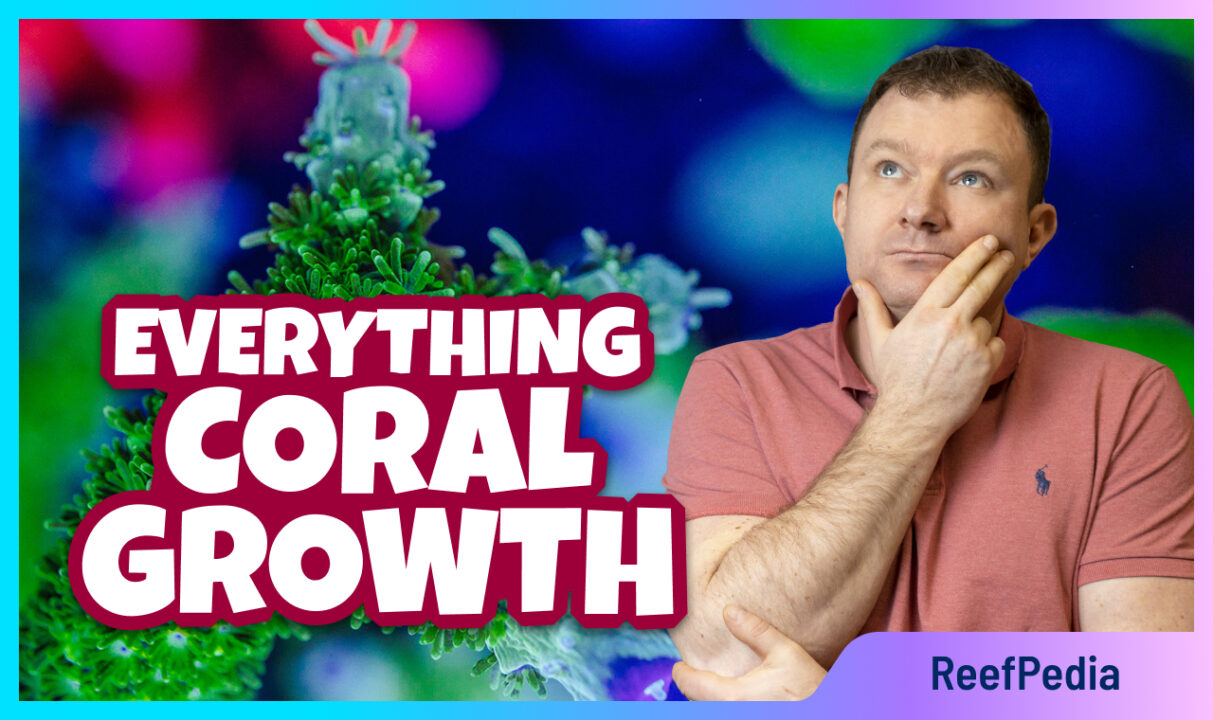Coral growth – Introduction
In this article, I aim to provide a comprehensive overview of coral growth. I’ll begin by explaining the fundamentals of coral growth and then delve into the key factors driving this process. Additionally, I’ll provide tips to help you effectively support tissue growth in corals.
What determines coral growth?
There are three main physiological processes that significantly influence coral growth:
- photosynthesis,
- heterotrophic feeding,
- calcification.
Coral growth and photosynthesis
Corals that host symbiotic algae within their tissues can derive a substantial portion of their energy resources from photosynthesis. These algae, known as zooxanthellae, use light energy to produce organic compounds from carbon dioxide and water. In this symbiotic relationship, corals provide the algae with shelter and nutrients. In return, the algae supply corals with a significant amount of organic compounds, including sugars and amino acids.
During photosynthesis, algae also produce oxygen, which enables their respiration. Additionally, corals absorb oxygen through diffusion, a process involving the natural movement of molecules from an area of higher to lower concentration. Corals can also extract oxygen from water through the oral tissue on their polyps (mesoglea). The mesoglea transports oxygen from the polyps to other parts of the coral, including the skeletal tissue, where it is utilized for respiration and metabolism.
Coral growth and functioning depend on oxygen availability. In low-oxygen conditions, corals may struggle to survive and reproduce. In some cases, when oxygen levels are too low, corals may switch to anaerobic functioning, leading to the production of harmful chemicals and potentially resulting in their death.
Since photosynthesis provides both energy and oxygen, it is crucial for coral growth.
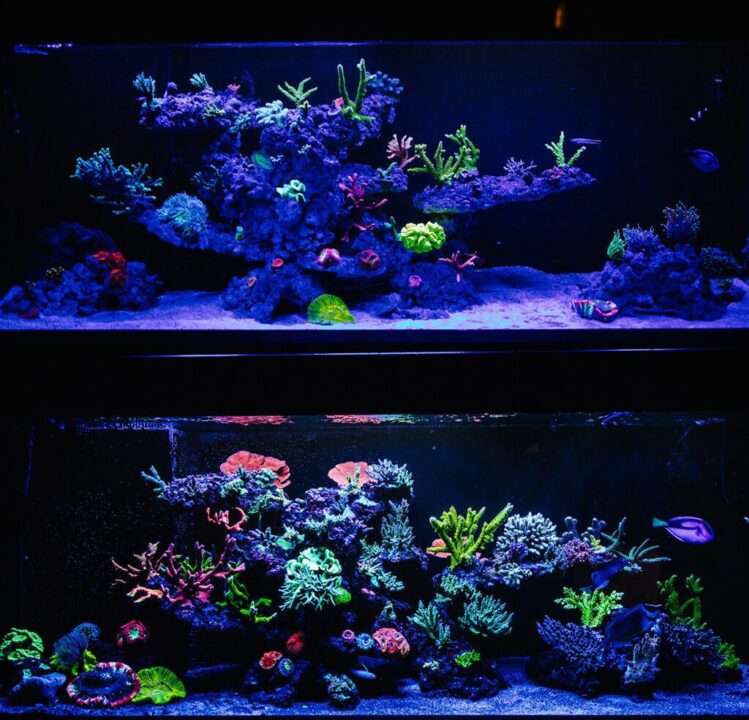
What affects photosynthesis efficiency in corals?
The efficiency of photosynthesis in corals depends on several factors, including:
- light quality,
- the presence of chlorophyll within symbiotic algae,
- the concentration of carbon dioxide (CO₂),
- the amount and type of zooxanthellae.
Light quality – Corals living in shallow marine waters, where light is abundant, typically have more zooxanthellae in their tissues. This allows them to achieve higher photosynthesis efficiency compared to those inhabiting deeper waters.
Presence of chlorophyll – Chlorophyll is a key photosynthetic pigment that absorbs light and converts it into chemical energy needed for photosynthesis.
Carbon dioxide concentration – Low CO₂ concentrations can limit photosynthesis efficiency, which in turn may reduce coral growth.
Amount and type of zooxanthellae – There are many types of these organisms, each varying in sensitivity to environmental conditions. Optimal conditions for one type of zooxanthellae may not suit another, potentially reducing photosynthesis efficiency and hindering coral growth.
Heterotrophic feeding and coral growth
In coral reef areas or aquariums with limited lighting, the light reaching corals may be reduced, affecting their ability to conduct photosynthesis and generate energy. In such cases, corals may increase their heterotrophic activity, meaning they obtain food from their surroundings to supplement their energy reserves.
Heterotrophic feeding in corals involves absorbing organic substances from the surrounding environment, usually through water filtration. Corals can consume food in the form of zooplankton, detritus, phytoplankton, bacteria, and other small organisms. Additionally, some corals are predatory, hunting smaller organisms like tiny fish and crustaceans.
However, for most corals, heterotrophic feeding generally constitutes only a small portion of their overall diet. Most corals are primarily photosynthetic, producing energy via photosynthesis conducted by symbiotic algae, such as zooxanthellae. Heterotrophic feeding serves as a dietary supplement, helping corals maintain their health and growth.
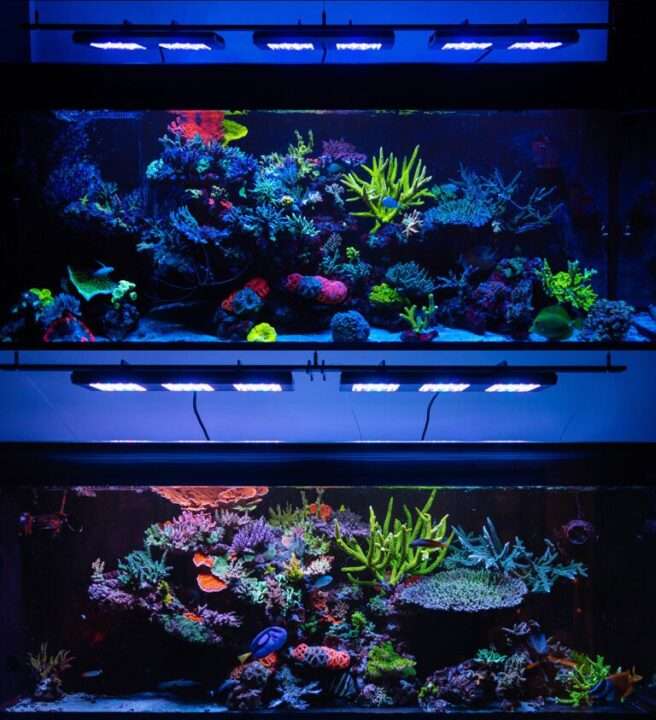
What affects the efficiency of heterotrophic feeding in corals?
The effectiveness of heterotrophic feeding in corals depends on several factors:
Availability of food in aquarium water – A lack or low concentration of food in the water may limit corals’ ability to capture nutrients.
Type and quantity of food – Corals typically prefer food in the form of plankton and detritus. However, some can capture larger food particles, like fish and crustaceans, depending on the coral species.
Duration of exposure to food – If food is available for too short a time, corals may not be able to capture enough to meet their dietary needs.
Water temperature – Higher temperatures can increase the digestion rate of food but may also cause internal damage to coral tissues. The recommended temperature range is 24–27 °C (72–80 °F).
Presence of toxic substances – Toxic substances in the water can inhibit corals’ ability to capture and digest food, as can impurities or overdoses of supplements.
Oxygen deficiency – Low oxygen levels in the water can slow corals’ metabolism, impeding their ability to capture and digest food effectively.
Calcification and coral growth
Calcification is the third key process responsible for coral growth. It involves the deposition of calcium ions (Ca²⁺) and bicarbonate ions (HCO₃⁻) onto an organic matrix created by the corals.
The calcification process depends on factors such as the presence of:
- enzymes,
- bacteria,
- symbiotic algae.
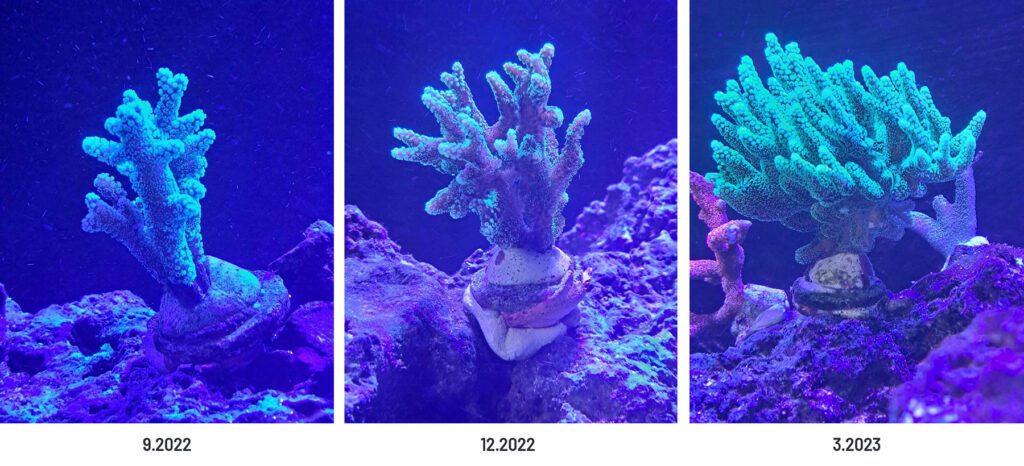
Enzymes influencing the calcification process
Enzymes play a crucial role in forming the calcium skeleton of corals. They regulate the rate of calcium secretion and deposition, as well as the internal pH of coral cells.
One of the most important enzymes involved in calcification is carbonic anhydrase. This enzyme catalyzes the reaction between carbon dioxide (CO₂) and water, resulting in the formation of bicarbonate ions (HCO₃⁻) and hydrogen ions (H⁺). The hydrogen ion is expelled from the cell, which lowers its internal acidity, facilitating skeleton formation.
Another key enzyme is ATPase. This enzyme catalyzes the breakdown of ATP molecules, releasing the energy needed to transport calcium ions into the cell. Once inside, calcium is used in the calcification process to support coral growth.
Additionally, corals contain enzymes that help regulate the pH within cells. An example of this is the Na⁺/H⁺ exchanger, which helps maintain a stable pH inside the cell.
All these enzymes are essential for effective calcification. Changes in enzyme function, caused by fluctuations in pH or temperature, can weaken the calcification process, potentially impacting coral growth rates.
Bacteria influencing the calcification process
The calcification process in corals relies not only on the presence of specific enzymes but also on interactions with microorganisms, including bacteria. These bacteria, known as endosymbiotic bacteria, can impact coral calcification in several ways.
First, endosymbiotic bacteria may assist in supplying calcium to corals through biological processes, such as mineralization or the breakdown of organic matter. For example, bacteria can release enzymes that break down organic material near the coral, releasing calcium from its components. This increases the calcium concentration in the water, contributing to the formation of calcareous skeletons essential for coral growth.
Second, some endosymbiotic bacteria can produce organic compounds, such as acetic acid, which corals can use in the skeleton-building process.
Finally, endosymbiotic bacteria help neutralize hydrogen ions produced during coral metabolic processes. Acidic conditions can reduce calcium levels in the water, making calcification more challenging. Bacteria that neutralize this acidic environment help maintain the appropriate pH necessary for calcification.
In summary, endosymbiotic bacteria play a significant role in coral calcification by supplying calcium, producing organic compounds, and neutralizing acidic conditions. However, the precise mechanisms and roles of these bacteria in coral calcification remain under active study.
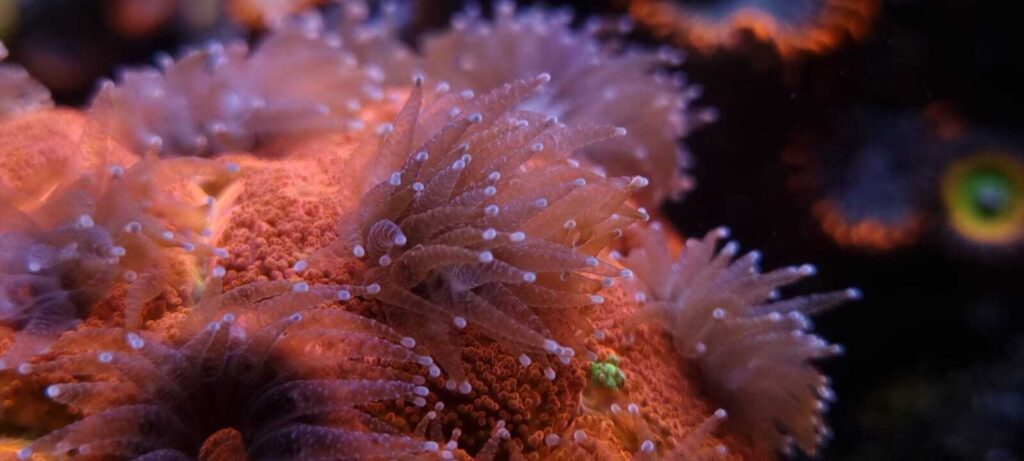
Photosynthesis and calcification – coral growth
In corals that host zooxanthellae algae, the calcification process is closely linked to photosynthesis. Coral skeletons are formed from calcium carbonate (CaCO₃), a byproduct of algal photosynthesis.
During photosynthesis, algae absorb carbon dioxide (CO₂) and water (H₂O) from seawater, converting them into sugars and oxygen (O₂). Additionally, bicarbonate (HCO₃⁻) is produced as part of this process and transported from the algae to the coral. Within the coral, bicarbonate reacts with calcium ions to form calcium carbonate (CaCO₃), which is deposited within the coral’s organic matrix, creating the coral skeleton.
Calcification is essential for corals, allowing them to form hard skeletons that serve as the foundation of their structure. These skeletons enable corals to survive in changing environmental conditions. However, the calcification process is highly sensitive to environmental changes, such as fluctuations in pH or seawater temperature. These changes can disrupt calcification, potentially hindering coral growth and development.
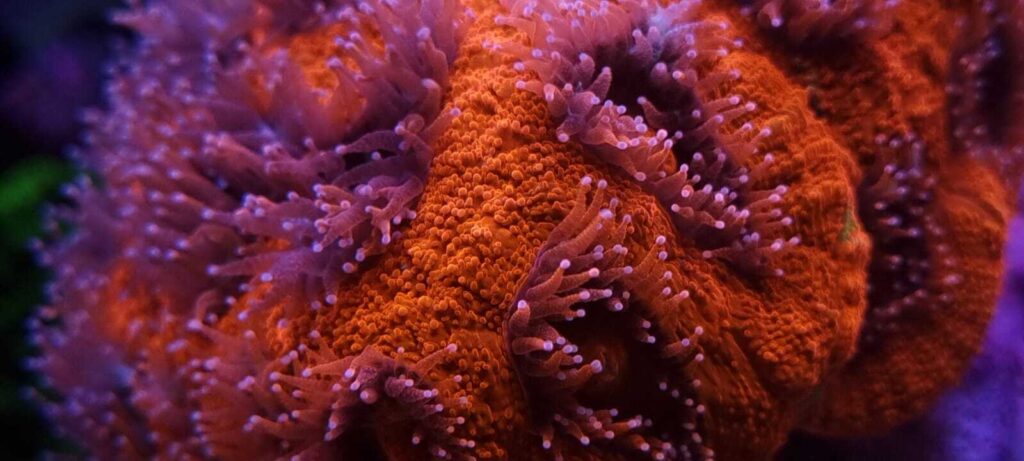
What affects the effectiveness of the calcification process in corals?
The effectiveness of calcification—the formation of calcareous skeletons in corals—depends on several factors:
Availability of calcium and bicarbonate ions – Corals require calcium (Ca²⁺) and bicarbonate (HCO₃⁻) ions for skeletal formation. A deficiency in either of these ions can limit the calcification process.
Water pH – Higher pH levels favor calcification by enhancing the solubility of calcium and bicarbonate ions in water, while lower pH levels can negatively affect corals, potentially causing skeleton dissolution. The recommended pH for seawater is 8.1–8.4.
Water temperature – Higher temperatures promote calcification by accelerating the chemical reactions necessary for skeletal formation. However, excessively high temperatures can lead to coral bleaching and weaken corals, reducing their calcification capacity. The recommended temperature range is 24–27 °C (72–80 °F).
Access to nutrients – Corals need adequate nutrients, such as amino acids, sugars, and fats, to produce proteins and other organic compounds that serve as the live matrix for their skeletons.
Light availability – Corals obtain energy through photosynthesis, facilitated by their symbiotic algae. Therefore, ensuring appropriate light quality is essential for optimal energy production.
Water flow – Proper water flow is crucial for effective calcification, as it facilitates the delivery of nutrients and calcium to corals while removing waste. Insufficient flow may lead to the accumulation of harmful substances like ammonia and carbon dioxide, which can negatively impact calcification.
Summary
In this article, I’ve described the processes that influence coral growth and the factors affecting their effectiveness. Corals require high-quality light to support healthy growth. They also need proper access to food and sufficient levels of essential elements. Maintaining a stable environment is crucial, which includes monitoring appropriate temperature and pH levels. Effective water circulation further supports coral health and growth.
The following articles are worth exploring to deepen your understanding of the complex topic of coral growth:

About the author

Marek Protasewicz
Reefkeeping has been my passion for over 10 years now. I love learning. The hobby has taught me many valuable lessons, patience being the best example. Combining work and passion is my path. I run Crazy Coral, a marine aquarium shop, for a number of years. Building this business from the scratch I learnt from my own mistakes at a heavy cost.
Later I managed a project aimed at development of methods for quick growth of Corals in non-natural conditions. The project was carried out by Get Sales, Poland. Presently, I am responsible for distribution strategy at Reef Factory, of which I am a co-founder. The company produces smart devices for marine aquaristics. The last projects I have been involved in are Social Reef and ReefPedia.

